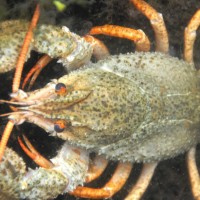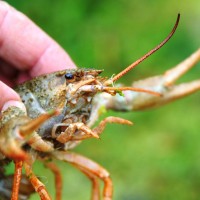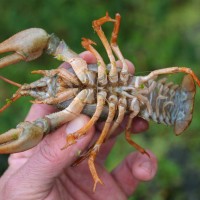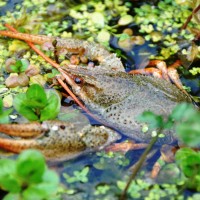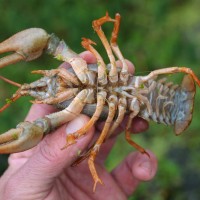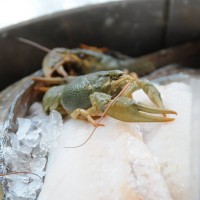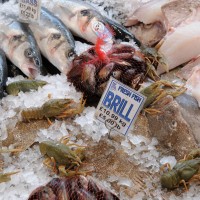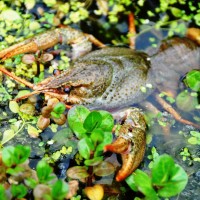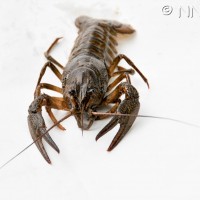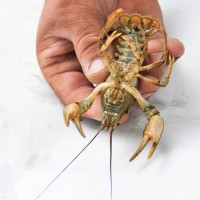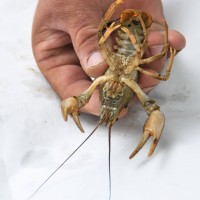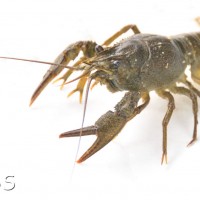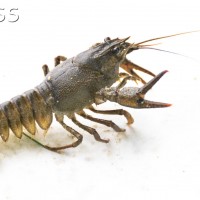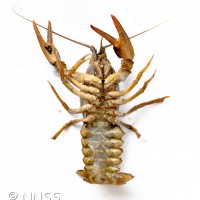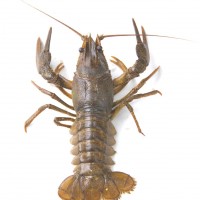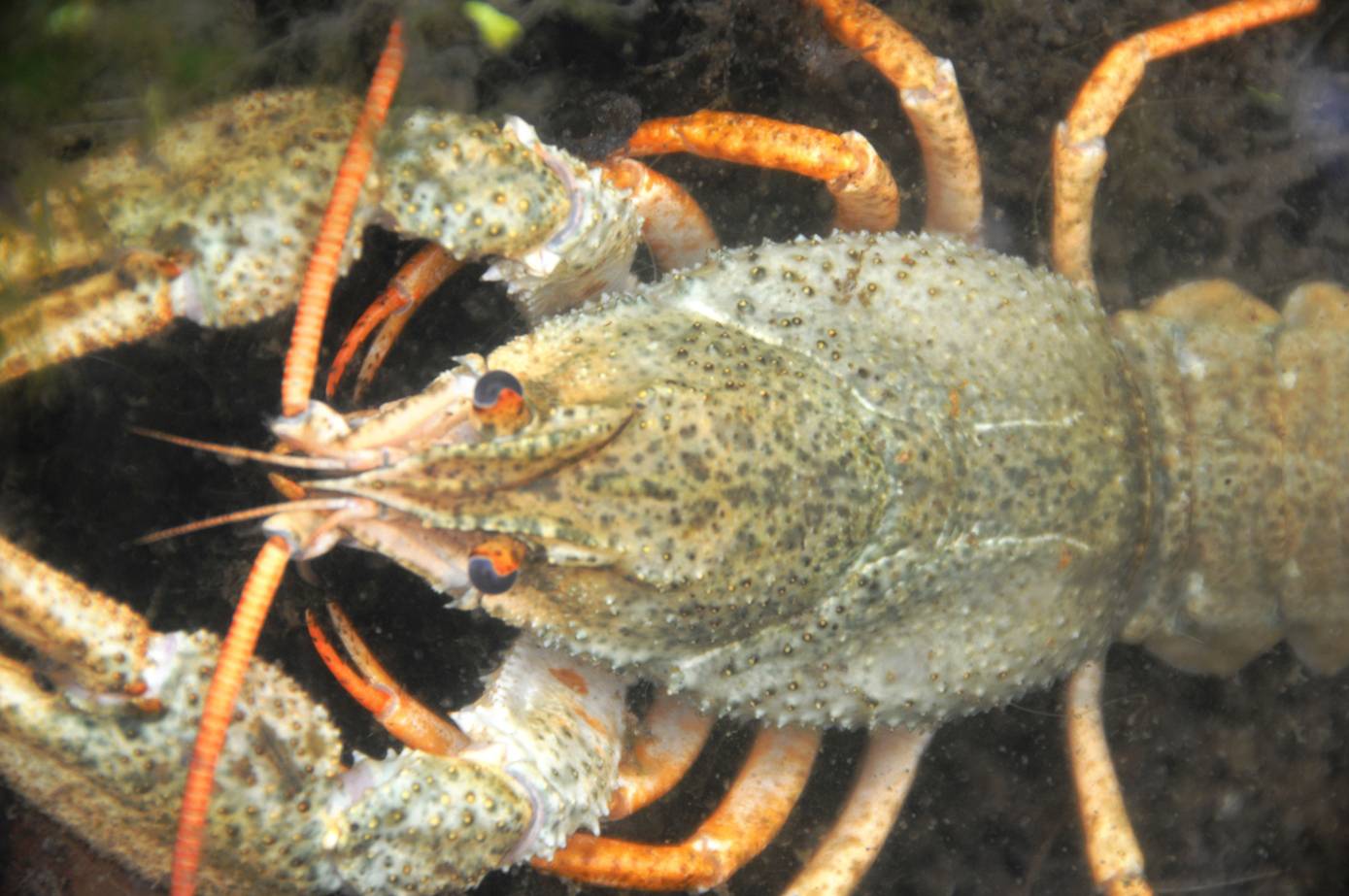
Turkish Crayfish - Astacus leptodactylus
Expand and collapse the sections below by clicking on the title or + / - icons.
Short description of Astacus leptodactylus, Turkish Crayfish
Adults are usually about 15cm long, but can reach up to 30cm in length. They have long, narrow claws that are rough on the upper surface, ridges behind the eye sockets and a long rostrum with parallel sides. They vary in colour from a pale sandy yellow or pale green to dark green or occasionally blue. Paler individuals may appear mottled. Leg joints are often orange.
Impact summary: Astacus leptodactylus, Turkish Crayfish
Turkish crayfish feed on macrophytes and invertebrates and so could affect structure and function of aquatic ecosystems, especially if at high densities. Crayfish could reduce fishery profits by competing with fish for food, stealing baits or causing declines in fish recruitment through loss of macrophyte habitat. It is likely that Turkish crayfish would outcompete white-clawed crayfish if ranges overlapped but they do not pass on crayfish plague.
Habitat summary: Astacus leptodactylus, Turkish Crayfish
Turkish crayfish are found in lakes, ponds and rivers in their native range and tend to prefer still water. They have occupied lake, reservoir and river sites in GB, including brackish water in the lower tidal reaches of a river in East Anglia.
Overview table
| Environment | Freshwater |
|---|---|
| Species status | Non-Native |
| Native range | Eastern Europe, Western Asia, Austria, Azerbaijan, Bosnia-Herzegovina, Bulgaria, Belarus, Greece, Croatia, Hungary, Israel, Iran, Kirgizistan, Kazakhstan, Moldova, Romania, Russia Central, Russia East, Russia North, Russia Northwest, Russia South, Slovakia, Turkey, Turkey-in-Europe, Georgia, Serbia |
| Functional type | Omnivore |
| Status in England | Non-Native |
| Status in Scotland | |
| Status in Wales | Non-Native |
| Location of first record | |
| Date of first record | 1975 |
Origin
The Turkish crayfish is native to western Asia and eastern Europe.
First Record
The Turkish crayfish was discovered in the southeast of England in the 1970s.
Pathway and Method
Turkish crayfish were brought into GB for sale in fish markets in the 1970s. It is likely that crayfish escaped from markets or were deliberately introduced into the wild in or around London. Crayfish from markets may have reached the Serpentine in Hyde Park through underground waterways. There is anecdotal evidence that a consignment of crayfish were put in Aldenham Reservoir in North London when a lorry broke down. It is assumed that subsequent transport of crayfish by humans established the more isolated populations.
Species Status
The Turkish crayfish is widespread across Europe. It has been introduced to at least 14 countries and has established large populations, but is struggling in some areas of its native range because of crayfish plague, water pollution and effects of agricultural irrigation. The Turkish crayfish has successfully established populations in the southeast of England, and other isolated populations in England and Wales, but high mortality caused by plague has recently been reported in populations in the River Colne near Colchester, the River Waveney in Norfolk and some populations around London.
Dispersal Mechanisms
It is likely that Turkish crayfish escaped from markets in London, or were deliberately released by people involved in the food industry. Turkish crayfish can walk overland to reach a water body and could have travelled through canals or underground waterways to reach other sites in London. It is possible that crayfish could be introduced by anglers using them as bait or as supplementary food for fish populations, or possibly by transfer with fish or vegetation between water bodies. Predators, such as herons, could also carry individuals between sites. It is not known how fast Turkish crayfish can disperse in water.
Reproduction
Individuals grow quickly and become sexually mature in their third year. They have high fecundity with females able to produce 200-400 eggs in a year. Large numbers of young are released in late spring. Populations can grow very rapidly in suitable habitat conditions.
Known Predators/Herbivores
Aquatic predators such as eels, pike, heron and otters will eat Turkish crayfish but are unlikely to have a significant impact on population persistence. Turkish crayfish could be outcompeted by the more dominant and aggressive signal crayfish. Turkish crayfish are also susceptible to crayfish plague but there is evidence that some individuals are resistant, and so populations can recover after outbreaks.
Resistant Stages
Turkish crayfish are very adaptable and tolerant of a wide range of environmental conditions. They can tolerate high salinity and are found in brackish waters in their native range and have successfully colonised the lower reaches of the River Waveney in Norfolk. They are active throughout the year.
Habitat Occupied in GB
The Turkish crayfish has established populations in lake, river, canal and stream habitats in GB, including brackish waters in the River Waveney estuary.
Environmental Impact
Turkish crayfish are omnivorous and could affect populations of macrophytes and invertebrates, and perhaps affect food chain interactions. Threat to white-clawed crayfish is considered to be low because Turkish crayfish are not carriers of crayfish plague, but it is likely that the non-native species would outcompete the native species if ranges overlapped.
Health and Social Impact
None known.
Economic Impact
There is no evidence that Turkish crayfish burrow so it is unlikely that they would cause extensive damage to riverbanks. Crayfish could reduce fishery profits by competing with fish for food, stealing baits or causing declines in fish recruitment through loss of macrophyte habitat.
Identification
UK Non-native organism risk assessment scheme- Version 3.3. Astacus leptodactylus- Turkish crayfish.
Biology, ecology, spread, vectors
Holdich, D.M. (2002) Distribution of crayfish in Europe and some adjoining countries. Bulletin Français de la Pêche et de la Pisciculture, 367, 611–650.
Holdich, D.M., Harlioglu, M.M. & Firkins, I. (1997) Salinity Adaptations of Crayfish in British Waters with Particular Reference to Austropotamobius pallipes, Astacus leptodactylus and Pacifastacus leniusculus. Estuarine, Coastal and Shelf Science, 44, 147-154.
Harlioglu, M.M. (2004) The present situation of freshwater crayfish, Astacus leptodactylus (Eschscholtz, 1823) in Turkey. Aquaculture, 230, 181-187.
Management and impact
UK Non-native organism risk assessment scheme- Version 3.3. Astacus leptodactylus- Turkish crayfish
General
Brickland, J., Holdich, D.M. & Imhoff, E.M. (eds) 2009 Crayfish conservation in the British Isles. Proceedings of a conference held on 25th March 2009 in Leeds, UK.
UK Non-native organism risk assessment scheme- Version 3.3. Astacus leptodactylus- Turkish crayfish.
Spotted this species?
Distribution map
View the Distribution map for Turkish Crayfish, Astacus leptodactylus from NBN Atlas
Risk assessment
Risk assessment for Astacus leptodactylus. See a full list of non-native species Risk assessments.

